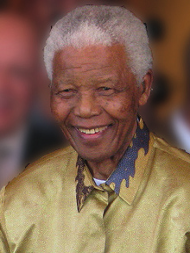Long Walk to Freedom
Autobiography, by Nelson Mandela. Little Brown [&] Co. 1995.
Nelson Mandel is one of the most charismatic politicians of the 20th century. Like Mahatma Ghandi and Martin Luther King he devoted his life to overcome an unjust, racist system.
 “During my lifetime I have dedicated myself to this struggle of the African people… I have cherished the idea of a democratic and free society in which all persons live in harmony and with equal opportunities. It is an ideal which I hope to live for and to achieve. But if needs be, it is an ideal for which I am prepared to die” With these words, spoken as the closing argument of the Rivonia Treason Trial, Nelson Mandela fired the imagination of his people’s fight against apartheid.
“During my lifetime I have dedicated myself to this struggle of the African people… I have cherished the idea of a democratic and free society in which all persons live in harmony and with equal opportunities. It is an ideal which I hope to live for and to achieve. But if needs be, it is an ideal for which I am prepared to die” With these words, spoken as the closing argument of the Rivonia Treason Trial, Nelson Mandela fired the imagination of his people’s fight against apartheid.
Nelson Mandela wrote most of his autobiography secretly, while he was imprisoned for 27 years on Robben Island by South Africa’s apartheid regime. Mandela tells about his childhood as son of Mandela of the Ixhiba, a clan of the Thembu, a Xhosa speaking tribe. He describes in details the events that shaped his life. He lost his father at the early age of nine and was relocated to live with relatives at the Royal household of Jongintaba Dalindyebo. The tribal meetings held there demonstrated the democracy customary in Tembuland. These meetings impressed him and laid the groundwork for his political engagement. He was the first of his family to go to school and to study law. His childhood name was Rolihlahla, which means “pulling the branch of a tree” or in other words, a “troublemaker”. When he was enrolled at a Mission school of the Methodist church, he was named Nelson and was strictly educated according to Western standards. But the Thembu cared for his traditional African education and Nelson underwent the ceremonies of initiation. He describes the circumcision at the age of sixteen and his coming of age. Avoiding an arranged marriage, he flew to Johannesburg, where he met all the key players in the fight against white domination. He joined the armed struggle led by most of the members of ANC Youth wing. Mandela applied himself passionately to his new found vocation. He met Walter Sisulu, another prominent political activist in South Africa, who became his friend for over six decades. Amid the turmoil of the struggle against apartheid, Nelson married his second wife, Winnie, but never enjoyed normal family life. He was constantly harassed by authorities. He had to leave the country and became a “most wanted” fugitive. Upon his return, Mandela was arrested and charged with treason in the Rivonia Treason Trial. He was sentenced to life imprisonment. He suffered much deprivation in section B of Robben Island. But despite the cruelty of the wardens, and the discrimination and humiliation, he remained free from bitterness, knowing that the liberation movements outside South Africa were becoming more powerful. The Free Mandela campaign started around 1980. After the dark years there was a sign of hope. He was offered freedom in exchange for renouncing violence, but he refused. In 1989, when William de Klerk took over as head of National Party and Botha resigned, many political prisoners were released. There was international celebration when Nelson Mandela freed on February 11, 1990.
Nelson Mandela describes his political ascension, and his belief that the struggle will continue in South Africa.
He became the first black president, leading a multi-racial democracy from 1994 to 1999. In strong contrast to his own former conviction, he gave priority to reconciliation, and has received over 250 awards, including the 1993 Nobel Peace Prize.
Mandela dedicated his book to “my six children, Madiba and Makaziwe (my first daughter) who are now deceased, and to Makgatho, Makaziwe, Zenani and Zindzi, whose support and love I treasure; to my twenty-one grandchildren and three great-grandchildren who give me great pleasure; and to all my comrades, friends and fellow South Africans whom I serve and whose courage, determination and patriotism remain my source of inspiration.”
Novels and Autobiographies
African Traditional Life
Amkoullel, A Fula Child
Autobiographies
Aké. The Years of Childhood
Dreams in a Time of War
Facing the Lion: Growing Up Maasai on the African Savanna
Long Walk to Freedom
My Story
Unbowed: A Memoir
Coming of Age
Mandela’s Ego
Miriam's Song
Nervous Conditions
Purple Hibiscus
The Mending Season
Emigration
Lessons in Humanity
A Long Way Gone. Memoirs of a boy soldier
Child Soldier: Fighting for my life
I die, but my Memory lives on
Praise Song
Sozaboy
Stories about Friendship



